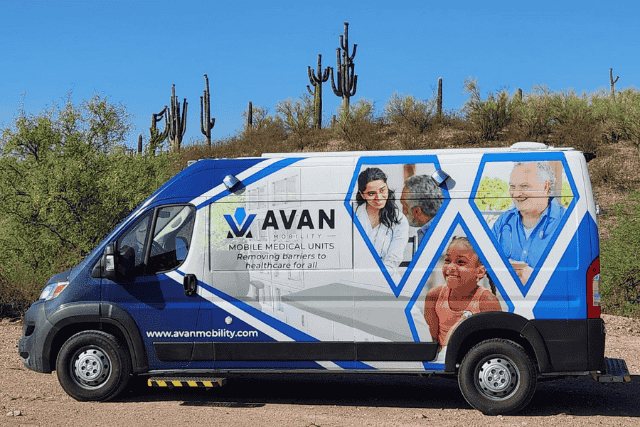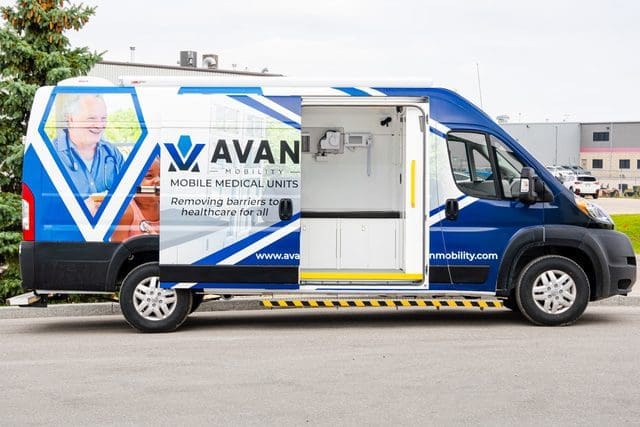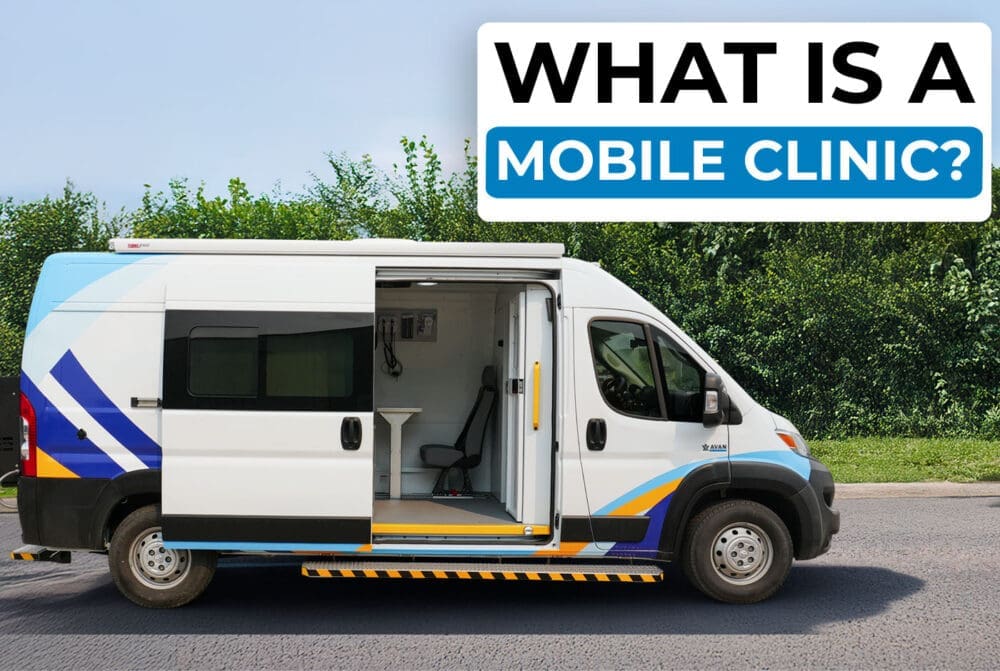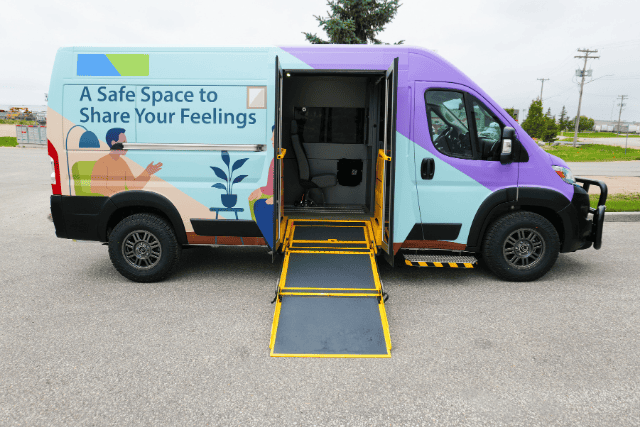We hear from many U.S. organizations that assume the lead time on mobile medical vans is a year or more. If your community needs care now, that can feel like forever. You might have a grant deadline coming up, patients who can’t reach a clinic, or a program ready to go but no vehicle. Every week without your van means more people go without care, your team feels the pressure, and your plans stay stuck in place.
Now imagine the other side of that wait. Your mobile health clinic is parked in the neighborhood, patients are getting help close to home, and your team is finally delivering the mobile medical services you’ve planned for months. The faster you get there, the sooner you close gaps in care.
At AVAN Mobility, we’ve been building vehicles for over 10 years to help healthcare networks like yours and CalOptima bring care where people are. Your mission drives you, and ours is to support it. We take time to learn about your patients, your program, and your goals before building, because no two communities are the same. We know we’re not the only manufacturer, so you deserve clear, unbiased answers about lead times before deciding.
In this article, you’ll learn:
- Typical timelines you can expect from AVAN Mobility
- How delayed lead times can affect your program and patients
What lead times can you expect from AVAN Mobility?

When you order from us, the lead time on mobile medical vans is usually about 3 to 4 months from the time we confirm your order. That’s often much shorter than what many people expect. We hear from buyers all the time who are surprised to find out they don’t have to wait a year or more.
How do we keep our lead times shorter? By planning ahead. Before your van even gets to our production floor, we’ve mapped out every step so things keep moving. Our goal is to get your mobile health unit to you as quickly as possible, without cutting corners on safety or quality.
Here’s a glance at what our 3–4 month process looks like:
- Planning and design: We work with you right away to confirm your layout and features.
- Chassis preparation: If your chassis is already in our yard, this step moves faster.
- Vehicle build: We install all medical-grade equipment, cabinetry, and accessibility features your program needs.
Why our timelines are faster:
- Chassis in stock: We keep certain models ready to go, which can save weeks.
- Clear process: We’ve refined our workflow over 10 years to remove delays.
- Specialized team: Our team focuses primarily on mobile medical units, so they know exactly what to do.
A shorter lead time on mobile clinics means you can start serving your community sooner and close healthcare gaps faster.
Why do some manufacturers have a longer lead time on mobile medical vans?
If you’ve been shopping around, you’ve probably noticed that the lead time on mobile medical vans can be very different from one manufacturer to another. Some will tell you it takes 9 months or even more than a year. It’s not always because they’re slow. There are a few common reasons their timelines stretch out.
Why are other lead times longer?
- Chassis availability: Some manufacturers don’t keep vehicles in stock. They wait until after you sign a contract to order one, and that order might take months to arrive.
- Too many projects at once: If a manufacturer takes on more builds than their shop can handle, each one moves more slowly.
- Heavy customization on every order: Some companies design every vehicle from scratch. While that sounds nice, it can add a lot of time before the first wrench even turns.
- Supply chain slowdowns: If they’re waiting on special parts from overseas or rare medical equipment, your build can get stuck in limbo.
- Limited experience with mobile medical units: A team that doesn’t specialize in these vehicles may have a harder time moving through each stage quickly.
When you’re comparing your options, it’s important to ask exactly how long the lead time on mobile clinics is and what’s included in that estimate. That way, you know if you’re waiting for the build itself, the parts, or simply a spot on their schedule.
What’s the real cost of slow lead times on mobile medical vans?
Waiting too long for your mobile medical van can slow down your plans, hurt your budget, and most importantly, keep people from getting the care they need. Here’s what can happen when the lead time stretches out.
Missed grant deadlines
Many mobile medical clinic projects are funded through grants, and those grants almost always come with strict deadlines. If the lead time on mobile medical vans is too long, you could lose the money entirely. That can delay your program for months or even years.
What can this mean for you?
- Lost funding: Money disappears when deadlines pass.
- Extra paperwork: Reapplying can eat up valuable time.
- Damaged trust: Funders may hesitate to work with you again.
When funding is gone, the community you planned to serve is left waiting. Your staff may also lose confidence in the project if they see it stall before it starts. Choosing a manufacturer with a realistic, shorter lead time helps keep your funding secure and your plans on track so you can get your mobile health unit on the road as quickly as possible.
Delayed program launches
Every week your mobile clinic van is delayed, your program can’t start. That means no patient visits, no outreach, and no mobile medical services in the field. Delays like this also put strain on staff and can hurt your program’s reputation.
Why does this matter?
- Lost momentum: Staff and volunteers may feel their work is wasted.
- Missed opportunities: Seasonal events or health fairs may pass by.
- Reduced trust: Communities may start doubting your timelines.
Programs need to launch while the need is high and the plan is fresh. Long delays mean the excitement you built in the community fades away, and people who were counting on you may look elsewhere for care. A shorter lead time on mobile clinics means you can move from planning to action faster, keeping your team motivated and your community engaged.
Ongoing patient care gaps
When the lead time on mobile medical units is long, patients who already face barriers to care must wait even longer. This can have serious consequences for both individuals and the community as a whole.
What can happen during long waits?
- Worsening health: Small problems may grow into serious conditions.
- Higher costs: Advanced conditions cost more to treat.
- Lost trust: Patients may feel forgotten.
If your community relies on your mobile health unit for screenings, check-ups, or chronic condition management, a delay can mean months without these services. That lost time can directly affect outcomes and increase healthcare costs in the long run. A faster turnaround on your mobile medical van helps you close these gaps quickly, giving your patients timely, reliable access to the care they need.
Increased staff workload and burnout
A delay in getting your mobile health units impacts your team, too. Without the proper vehicle, staff may need to find workarounds to deliver care, which can be exhausting.
How do delays affect your staff?
- Burnout: Extra hours and limited tools take a toll.
- Turnover risk: Overworked employees may choose to leave.
- Lower efficiency: Staff can’t reach as many people without the van.
When staff are stretched thin, morale drops. You may also face added costs if you’re paying for employees who can’t fully do their jobs until the mobile medical clinic arrives. Choosing a partner with a shorter lead time on mobile health units helps your team work at their best, with the right tools in place, so they can focus on caring for patients instead of struggling to fill gaps.
Missed seasonal demand
Some mobile medical units are designed for specific seasons or events. A mobile flu shot clinic needs to operate before flu season peaks. School health checks need to happen before the school year begins. If your mobile clinic van arrives late, you can miss the entire window and wait another year.
What this means:
- Lost opportunities: You can’t run the program until the season comes back.
- Reduced impact: Fewer people reached during critical times.
- Frustration: The community may lose interest before you start.
Timing matters in healthcare. A shorter lead time on mobile medical units means you can plan confidently around these important seasonal needs and actually deliver services when they matter most.
Drive your program forward with lead time clarity

You came here because you wanted to know how long the lead time on mobile medical vans really is and how that affects your mission to deliver care.
You’ve learned:
- Challenge (then): Waiting too long for your mobile clinic meant missed grants, launch delays, and burnout.
- Solutions (now): Knowing a trusted 3–4-month build timeline helps you stick to your plan, protect your funding, and support your team.
At AVAN Mobility, we bring over a decade of hands-on experience in turning ideas into real, rolling solutions. We’re engineers, creators, and human-centered thinkers who know mobile medical vans inside and out. Our track record shows we build fast, we stay flexible, and we genuinely listen to your goals, because your program’s success is our success.
We’re leaders in this space not by chance, but by caring deeply and acting deliberately. If you have any questions, click the button below to talk to a mobility expert.





